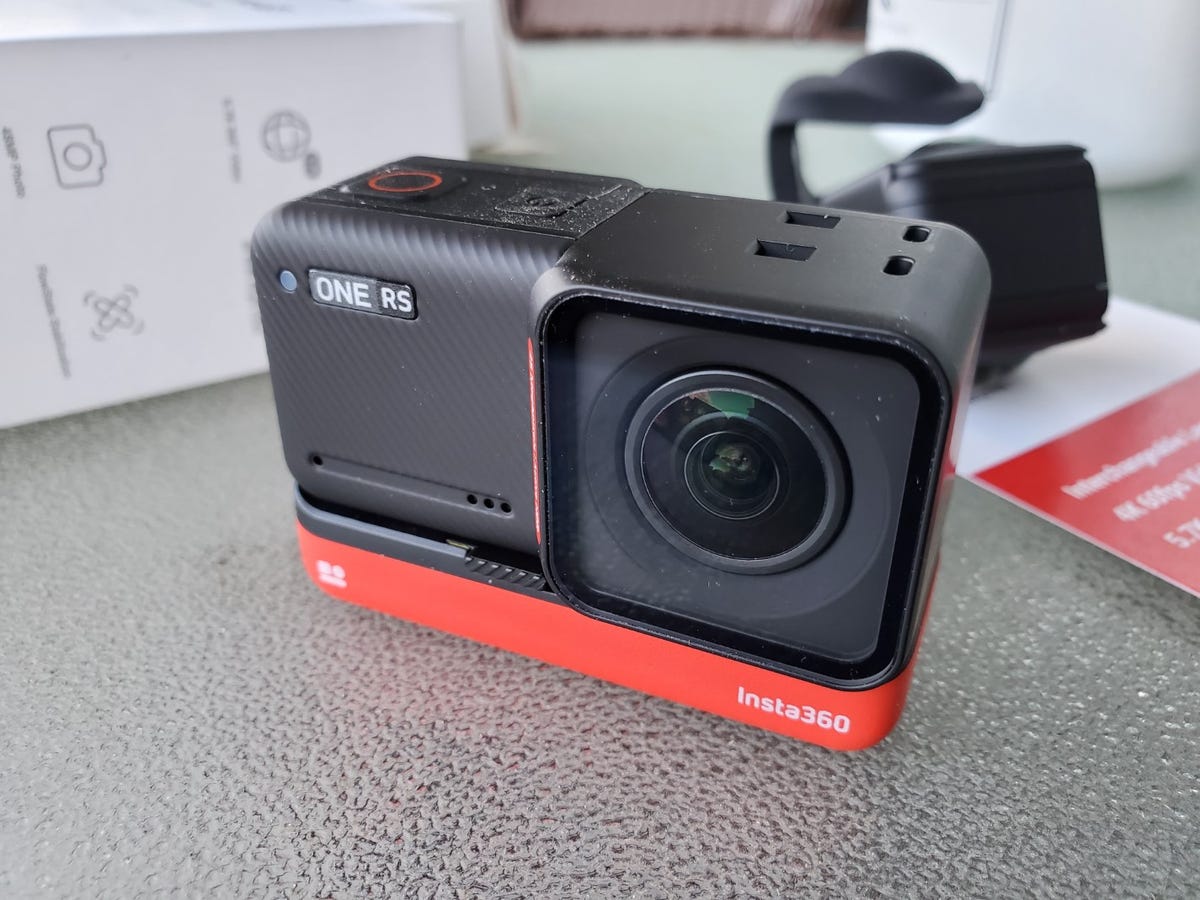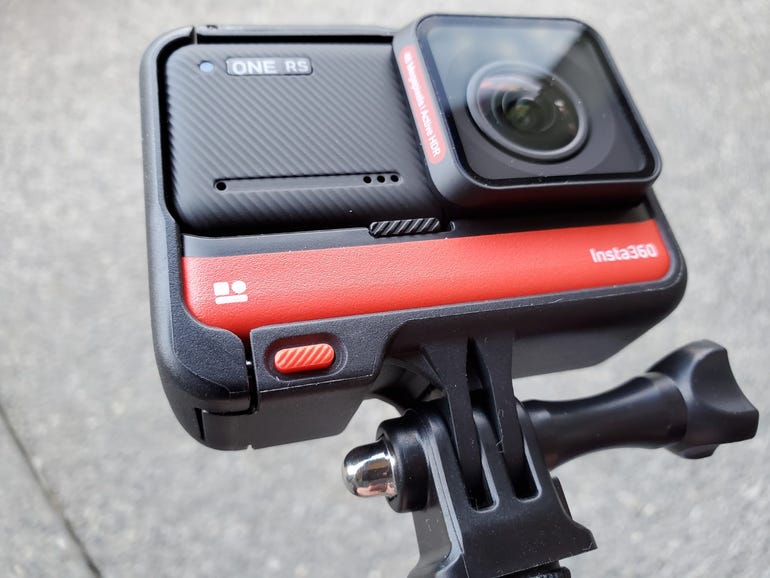Insta360 One RS first look review: One compelling action camera, three swappable lenses

Matthew Miller/ZDNet
Some people enjoy getting out and seeing the natural world around us in a variety of ways, whether that be hiking up mountain trails, skiing down chilly slopes, diving in a tropical paradise, or viewing heart-pounding Formula 1 racing around the circuit. The new
Insta360 One RS
is an action camera designed to be as versatile as you need so that one camera can capture all of your life experiences.
Last year I tried out the Insta360 One X2 and loved the capability of the camera and the powerful editing software that lets you capture content and worry about all of the details later. The Insta360 One RS offers an experience similar to what you see on a GoPro action camera but with even more capability thanks to its interchangeable lenses.
The modular camera system separates into three primary pieces; the core, the lens, and the battery/mount. It’s a brilliant innovation and because I’ve only had it for a couple of weeks I need more time to develop my in-depth review as I continue capturing the world around me with two of the three available lenses.
Thankfully, Insta360 built the new One RS to be compatible with the previous One R camera system so that you can upgrade pieces when you want and also trust that future updates will also likely support the system you purchase today.
Also: Insta360 One X2 camera review: Capture everything, edit and share later
Hardware
The interchangeable lens system was first released by Insta360 in the
One R camera system.
The new One RS model improves upon the One R with a more powerful core, upgraded half-inch 48MP image sensor in the 4K Boost Lens, and redesigned mounting bracket.
The red and black base of the One RS has two spots for the core and a camera lens with a release button along one side of the base. The base houses the battery so it serves as the foundation upon which the rest of the camera system is built. You can also purchase a boosted battery base that adds a higher capacity battery to the camera assembly.
The core is the second essential building block for the camera system and whatever modular assembly you desire must include the core. The core houses the processor with one side containing the color touchscreen for managing the camera and serving as the viewfinder. You can have the core attached so that the display is facing you for selfie content capture, which is handy while vlogging or capturing content where you are the only subject.
The core has a power button and capture button on top with a water-resistant access panel on one side for the USB-C port and microSD storage card. Upgrades to the new core include an additional microphone, 50% faster Wi-Fi for faster mobile file transfers, an instant zoom function, and a quick menu to access preset shooting modes.
The third and final part of the camera system is the lens. Three lens options are available for the One RS camera system, including the 4K Boost Lens that supports active HDR and 6K widescreen mode, a dual-lens 360 module for 360 degree capture at up to 5.7k, and a 1-inch 5.3k wide-angle lens that was co-engineered with Leica. I do not have the Leica lens available for testing so I will not be covering that in the full review.
The Insta360 One RS Twin Edition retail unit I am testing includes the battery base, RS core, 4K Boost Lens, and 360 dual-lens. In addition, the retail package contains the new mounting bracket, 360 silicone lens cap, and USB-C charge cable. The new mounting bracket is essential for using the
Invisible Selfie Stick
or mounting the camera on any other type of mounting bracket. It’s fantastic that Insta360 includes this mounting bracket in the base bundle. The redesigned mounting bracket has a quick-release mechanism for switching lenses on the go, a windproof mic cover, and a heat-dissipating panel to keep your camera cool while recording.

Matthew Miller/ZDNet
I was also sent a
Quick Reader,
available for $59.99, to test out. The Quick Reader lets you pop out the microSD card from the camera, put it into the reader, and then flip open to reveal the Lightning or USB-C connector as you connect to your iPhone or Android phone for quick file transfer.
You can also put a microSD card into the Quick Reader, connect the Quick Reader to your camera, and select to have content captured directly to that external microSD card. It’s a handy accessory for fast file transfer, especially useful if you do not have large capacity microSD cards or want to share content soon after you capture it. Eliminating a Wi-Fi connection to transfer files also saves your battery life for shooting.
Specifications
- Storage: microSD card slot
- Wireless connectivity: Bluetooth 5.0 and 801.22 a/b/g/n/ac WiFi
- Other: 48 kHz AAC audio format with wind reduction and stereo audio. 6-axis gyroscope in each of the three camera modules
- Waterproof rating: IPX8
- Battery life: 1445 mAh in the standard base. 60 minutes to charge. 75 to 84 minutes run time with the various lens modules.
- 4K Boost Lens: F2.4, 125.3 grams, 4k@30fps, FlowState in-camera stabilization
- 360 lens: F2.0, 135.3 grams, 5.7k@30fps, 25fps, 24fps. 4K@50fps and 30fps, 3K@100fps
- 1-inch wide-angle Leica lens: F3.2, 163 grams, 1-inch sensor, 19MP stills, 5.3k@30fps, FlowState in-camera stabilization
Camera software
You can charge up the Insta360 One RS, insert a microSD card (up to 1TB), and start recording or capturing still images without any smartphone connection. The square LCD touchscreen supports taps and swipes so when it first turns on it shows the current views of the cameras. Tap once to pop up various status indicators. With these indicators shown swipe from the top and swipe left and right to view all of the controls. These include display brightness, lock mode, LED toggle, screen rotation, voice control, and more settings. Other settings include connection management, Bluetooth remote, WiFi settings, AirPods connectivity, audio mode, and more.
From the main viewfinder, swipe up from the bottom to view images and videos that you have previously captured. Swipe from left to right to move between all of the available shooting modes associated with the lens you have attached to the base. The number and type of available shooting modes will vary with the three optional lenses. Swipe from right to left to access specific settings for the selected camera mode, including format, ISO, white balance, and more.
On the main viewfinder, you can tap various icons to quickly change options. This includes your camera mode, resolution settings, and the Quick Menu when you tap on the upper right of the display.
Also: COROS Vertix 2 outdoor sports watch review: Challenging Garmin with longer battery life, lower price, dual GNSS support
Insta360 smartphone software
The free Insta360 smartphone software is very well done and one of the best pieces of software I have used for a camera experience on a phone. When you first launch the app you can set up an account and then connect the camera. The camera connects via Wi-Fi and Bluetooth for content transfer and camera control functions. In my experiences, the camera and phone connect quickly and reliably on a consistent basis.
The software has tutorials to help you get the most out of your new camera, as well as submitted content from other users so you can be inspired to capture your world too. Along the bottom, there are tabs for explore, album, camera control, stories, and settings.
In album view, you can see what has been captured on your camera and then select content to download to your phone for further editing and use. There are a host of viewing and editing tools available in the app. You can change the aspect ratio of the content, view tiny planet shots, apply the PureShot auto enhancement, take a snapshot of the content, enable Multiview, add music, change video speed, and much more.
Multiview is a cool option that shows you different views of the content in another window that you customize so you can see things like people’s reactions as something is happening in the video. FlashCut uses AI to find the best moments in your clips and edits them together with music so you can quickly create and share interesting content with little effort on your part, which has always been one of the major challenges with capturing lots of video content.
When you connect and control your One RS from your phone, a host of modes are available to you. These include burst, interval, night shot, HDR photo, photo, video, timelapse, HDR video, bullet time, timeshift, and live. While auto mode for these is on by default, you can change to manual mode and control specific camera settings with your phone.
The One RS can also be used as a webcam or live-streaming camera when connected to your smartphone or computer so it is an extremely versatile camera. You can also download and install the Insta360 Studio desktop software if you want to view and edit your content on your computer instead of your phone.
First impressions
As a modular system, several purchasing options are available. The
Twin Edition
includes the powerful combination of the 4K Boost Lens and 360 Lens, and offers the best value at $549.99. For users looking to upgrade their wide-angle action cam setup, the
4K Edition
retails for $299.99, while the
1-Inch Edition
retails for $549.99. The Core, battery and Mounting Bracket are also available to purchase as a bundle.
The new
Insta360 One RS
improves upon the One R in key capabilities while also providing a platform for expansion so One R owners can upgrade the core and continue to use existing lenses. It’s a compelling option for creators looking for multiple options for capturing and sharing content with great results.
We will continue to investigate the world around us and capture content in various scenarios in order to fully evaluate the camera system. Stay tuned for our full review and if you have specific questions or scenarios you want us to test out with the camera please leave a comment below.




